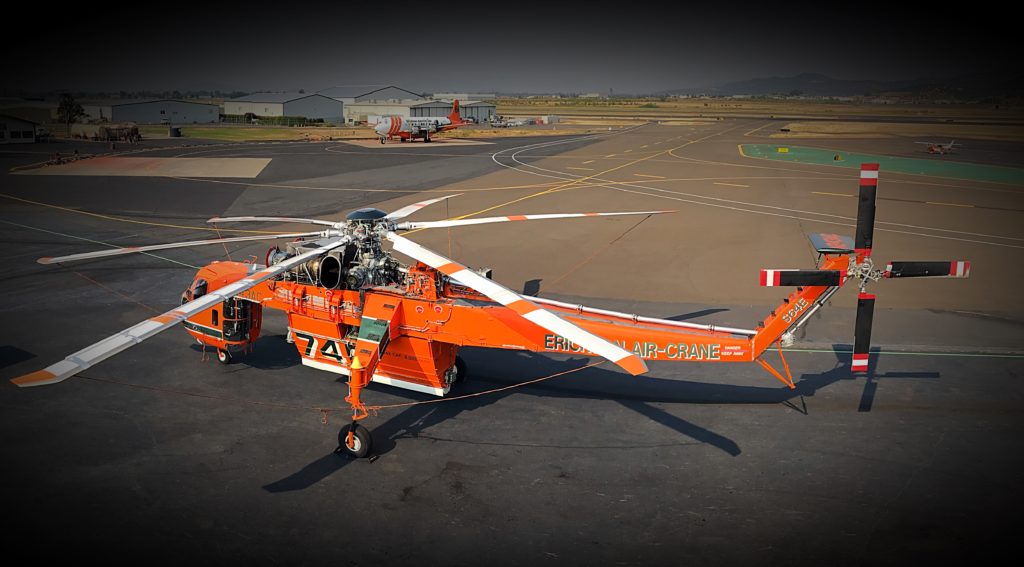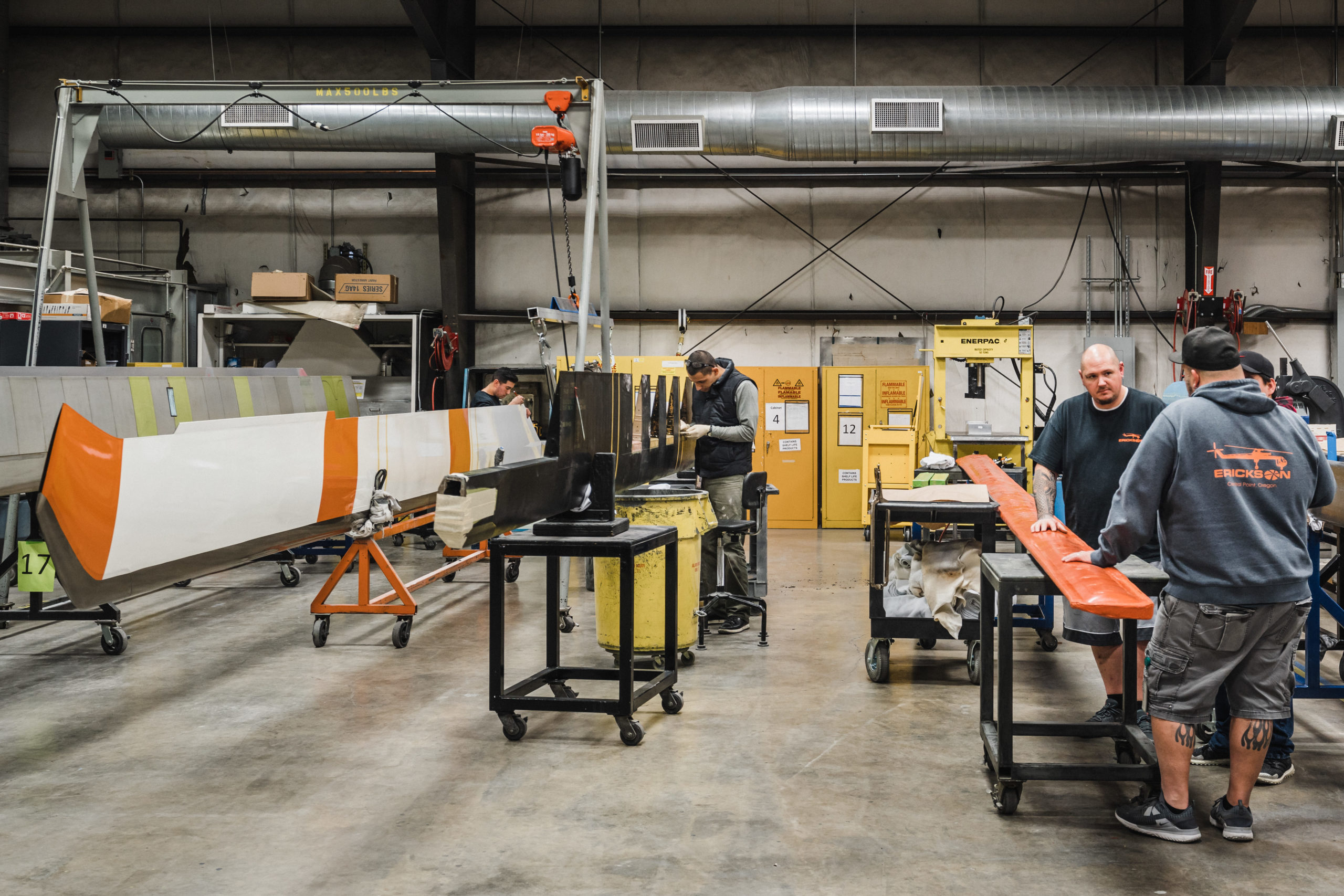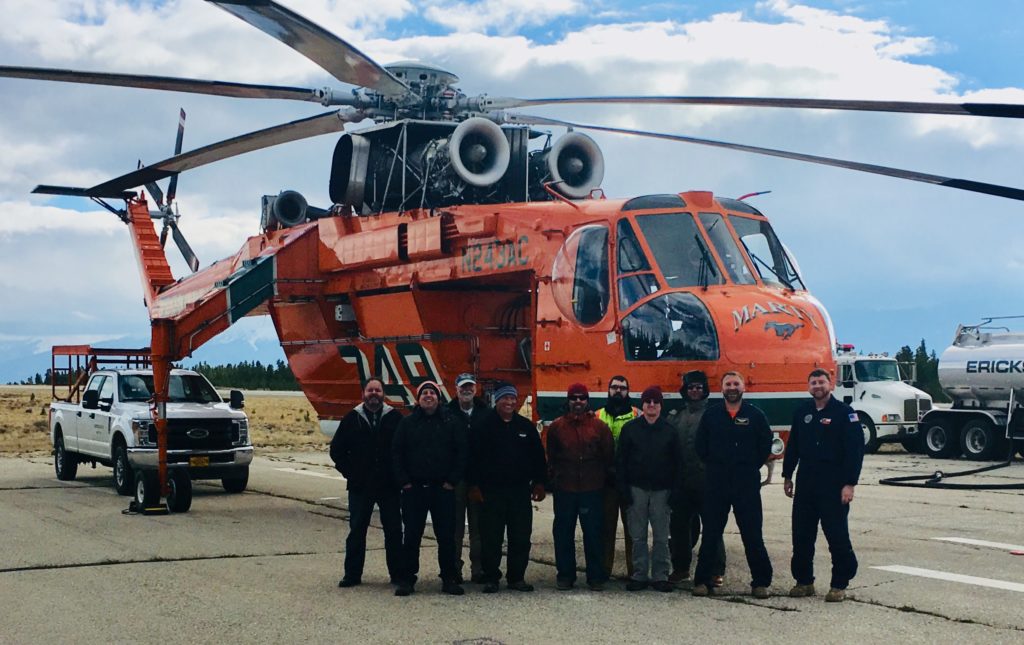Over 10 years ago, Erickson determined that they needed to innovate their rotor blades for the S-64 – here’s more about solving this engineering challenge.
The aerospace industry moves notoriously slow. The biggest reason is safety, followed by cost. To do anything in aircraft means safety for people while innovating at a manageable cost. For Erickson Incorporated, they realized about 10 years ago, in 2011, that they needed to innovate the main rotor blades on the S-64 Air Crane® Helicopter.
The traditional aluminum blades were already about 50 years old and were expensive and time intensive to produce. During the project, over 60 Erickson employees – across departments, were involved. Additionally, several industry partners came alongside Erickson for design, prototyping, and testing – including Sikorsky (the original developer of the S-64) and the U.S. Army.
William (Billy) Johnson, chief engineer for Erickson, was on the project from its early stages. He said that this project was one of the biggest challenges that he, other team members, suppliers, and partners have undertaken.
The outcome of the project was the development of composite main rotor blades for the S-64. The new blades are easier to manufacture, work better in high-hot conditions, and can lift significantly more. The lift is mission-critical for the S-64 in its ability to fight fires by carrying water, transporting heavy machinery, and preserving life and property.

The S-64 is a workhorse of the helicopter world and it now has the modernized blades to take it into the next century.
But the project wasn’t without some blood, sweat, and tears according to Johnson.
“Erickson’s composite main rotor blade (CMRB) program is the type of complex project typically done only at much larger manufacturers. Our work on the CMRB reflects a level of sophistication here at Erickson that the aerospace and manufacturing industries are becoming much more aware of now,” said Johnson.
The project included the engineering department, a blade shop, rotor head shop, pilots, and aircraft maintenance crews, said Johnson. He said the engineering challenges to solve were demanding and included, “A heavy use of math, physics, and aerodynamics.”
They had to calculate aerodynamics to understand the lift and performance factors of the blades. There were vibration and fatigue calculations, “There were ups-and-downs and times we worried about the project,” Johnson said. He indicated that “A weak set of engineers might have abandoned the project.”
One of the first testing excursions was to Peru for flight testing. He said they had a team of 15 people that traveled from Oregon to Tacna, Peru (the low-altitude test site), with plans on going up to the high altitude of Cuzco, Peru and then when they arrived, they found too many problems with logistics and were forced to come home unsuccessful. This testing was eventually completed successfully in Mesa, AZ, Bakersfield, CA and Leadville, CO.
They then went to a fatigue testing lab with the Army Laboratory, Aviation Development Directorate – Eustis (ADD-E) in Virginia and found that the Lab couldn’t handle the rotor blade. Both parties were concerned that the blade would ruin the testing facility.
Luckily, they were able to go back to a trusted, lifetime partner, Sikorsky (Lockheed Martin), the OEM who created the original S-64, then called the CH-54 Skycrane for blade testing. They conducted vibration and fatigue tests as if the blades were on a helicopter lifting loads. They tested everything with the most stringent conditions.
“If you can make the blade fail during an elevated load fatigue test such as this, then when you develop cracks, you know how many hours it can run,” said Johnson.

But there were other obstacles. The new blades are made with a composite material, that was provided by Toray Composites. But Johnson said that getting the layers of composite material and adhesive baked in an industrial oven at a high temperature doesn’t always yield a perfect result the first time.
“Go build one, it is hard. There are layers of composite and adhesive, pressurized and cured. From there we would cut it up into pieces to find out where the construction was good and bad. We would then adjust temperatures, the mold, and keep doing prototypes until it was done correctly,” Johnson said.
He added that ultimately, the process must be perfectly repeatable and documented so that it can be replicated in a flawless capacity.
The new blades are now being sold to S-64 owners in other countries, and the Erickson fleet in the U.S. will slowly be upgraded. Although Johnson said that the process of upgrading is just getting started and will take a while.
Johnson said that the entire engineering team, blade shop, rotor shop, pilots, and crew – plus all partners and suppliers are proud of the outcome. They feel that they were involved in a project that serves the national interest.

“The result of everything we are doing, the results are to save lives, protect property, and support the military. Those are amazing things – it’s not like we are selling popsicles. The work we do is in the national interest. It is critically important to saving property, forests, lives, and more. We can feel very proud about it,” Johnson concluded.
The blades were approved by the FAA, for several Erickson-related aircraft, in the following order – Certification was as follows: S-64E Feb. 2020; CH-54A July 2020; S-64F & CH-54B Dec. 2020.
There are 45 operational S-64s and CH-54s in the world and five of them have the blades. Johnson thinks they will update about five per year going forward. It is expected that all S-64s and CH-54s will have the new blades within 10 years.
With the rotor blade project, it was crucial that they find and implement a new solution. Erickson and so many others rose to the occasion to create remarkable results that will positively impact many people and situations in the U.S., and around the world.
There were many Erickson employees, partners, and suppliers who deserve credit for an outstanding job:
- Billy Johnson, Chief Engineer
- Ilex Brandenberger, Senior Structural Engineer
- Mark Brown, Systems Engineering Manager
- Gari Wolff, Engineer/Electrician
- Tim Frazier, Project Engineer
- Jeff Johnson, Sr. Manager of Obsolete Parts and Design
- JR Avgeris, Asst. Director of Engineering
- Terry Stead, Technical Publications Manager
- Vic Shami, Structural DER, 3rd party
- Bob Williams, Flight Test Pilot DER, 3rd party
- Toray Advanced Composites
- Advanced Technologies Incorporated (ATI)
- Continuum Dynamics
- The Army Laboratory (Virginia)
- Sikorsky, a division of Lockheed Martin
- Northern Aero
- Dale Roberts
- Alex Sked
- Ian Gibson
- Brock Strunk
- Sean Bradshaw
- Jared Plumb
- Kevin Johnson
The Erickson Blade Shop, including:
- Amanda Hammerschmith, Blade Shop Manager
- Sean Leib, Composite Blade Lead
- Sam Foster, Manufacturing Manager
- Jason Hughes, Blade Repair Lead
- Jared Blackmon, Composite Technician
- Tony Crume, Aircraft Production and Maintenance Asst Manager
- Brad Pepper, Erickson Test Pilot
- Adam Warner, Crew Chief
- Jeff Sell, Crew Chief

